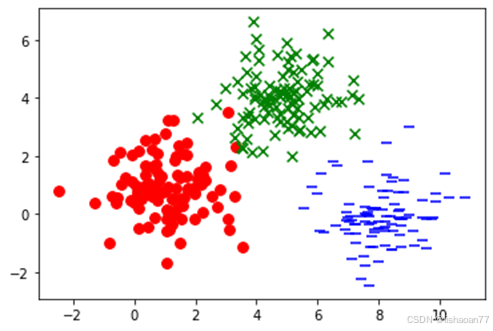用TensorFlow进行逻辑回归(五)
Softmax分类
#List3-50
%matplotlib inline
import numpy as np
import tensorflow as tf
import matplotlib.pyplot as plt
x1_label0 = np.random.normal(1, 1, (100, 1))
x2_label0 = np.random.normal(1, 1, (100, 1))
x1_label1 = np.random.normal(5, 1, (100, 1))
x2_label1 = np.random.normal(4, 1, (100, 1))
x1_label2 = np.random.normal(8, 1, (100, 1))
x2_label2 = np.random.normal(0, 1, (100, 1))
plt.scatter(x1_label0, x2_label0, c='r', marker='o', s=60)
plt.scatter(x1_label1, x2_label1, c='g', marker='x', s=60)
plt.scatter(x1_label2, x2_label2, c='b', marker='_', s=60)
plt.show()

xs_label0 = np.hstack((x1_label0, x2_label0))
xs_label1 = np.hstack((x1_label1, x2_label1))
xs_label2 = np.hstack((x1_label2, x2_label2))
xs = np.vstack((xs_label0, xs_label1, xs_label2))
labels = np.matrix([[1., 0., 0.]] * len(x1_label0) + [[0., 1., 0.]] * len(x1_label1) + [[0., 0., 1.]] * len(x1_label2))
arr = np.arange(xs.shape[0])
np.random.shuffle(arr)
xs = xs[arr, :]
labels = labels[arr, :]
test_x1_label0 = np.random.normal(1, 1, (10, 1))
test_x2_label0 = np.random.normal(1, 1, (10, 1))
test_x1_label1 = np.random.normal(5, 1, (10, 1))
test_x2_label1 = np.random.normal(4, 1, (10, 1))
test_x1_label2 = np.random.normal(8, 1, (10, 1))
test_x2_label2 = np.random.normal(0, 1, (10, 1))
test_xs_label0 = np.hstack((test_x1_label0, test_x2_label0))
test_xs_label1 = np.hstack((test_x1_label1, test_x2_label1))
test_xs_label2 = np.hstack((test_x1_label2, test_x2_label2))
test_xs = np.vstack((test_xs_label0, test_xs_label1, test_xs_label2))
test_labels = np.matrix([[1., 0., 0.]] * 10 + [[0., 1., 0.]] * 10 + [[0., 0., 1.]] * 10)
num_labels = 3
train_size, num_features = xs.shape
W = tf.Variable(tf.zeros([num_features, num_labels]))
b = tf.Variable(tf.zeros([num_labels]))
learning_rate = 0.01
training_epochs = 1000
batch_size = 100
optimizer = tf.optimizers.SGD(learning_rate)
for step in range(training_epochs * train_size // batch_size):
offset = (step * batch_size) % train_size
batch_xs = xs[offset:(offset + batch_size), :]
batch_labels = labels[offset:(offset + batch_size)]
X=tf.cast(batch_xs,tf.float32)
Y=tf.cast(batch_labels,tf.float32)
with tf.GradientTape() as g:
y_model = tf.nn.softmax(tf.matmul(X, W) + b)
cost = -tf.reduce_sum(Y * tf.math.log(y_model))
gradients = g.gradient(cost, [W, b])
# 更新梯度
optimizer.apply_gradients(zip(gradients, [W, b]))
if step % 100 == 0:
print (step, cost.numpy())
W_val = W
print('w', W_val.numpy())
b_val = b
print('b', b_val.numpy())
#train_op = tf.train.GradientDescentOptimizer(learning_rate).minimize(cost)
correct_prediction = tf.equal(tf.argmax(y_model, 1), tf.argmax(Y, 1))
accuracy = tf.reduce_mean(tf.cast(correct_prediction, "float"))
print("accuracy", accuracy.numpy())
